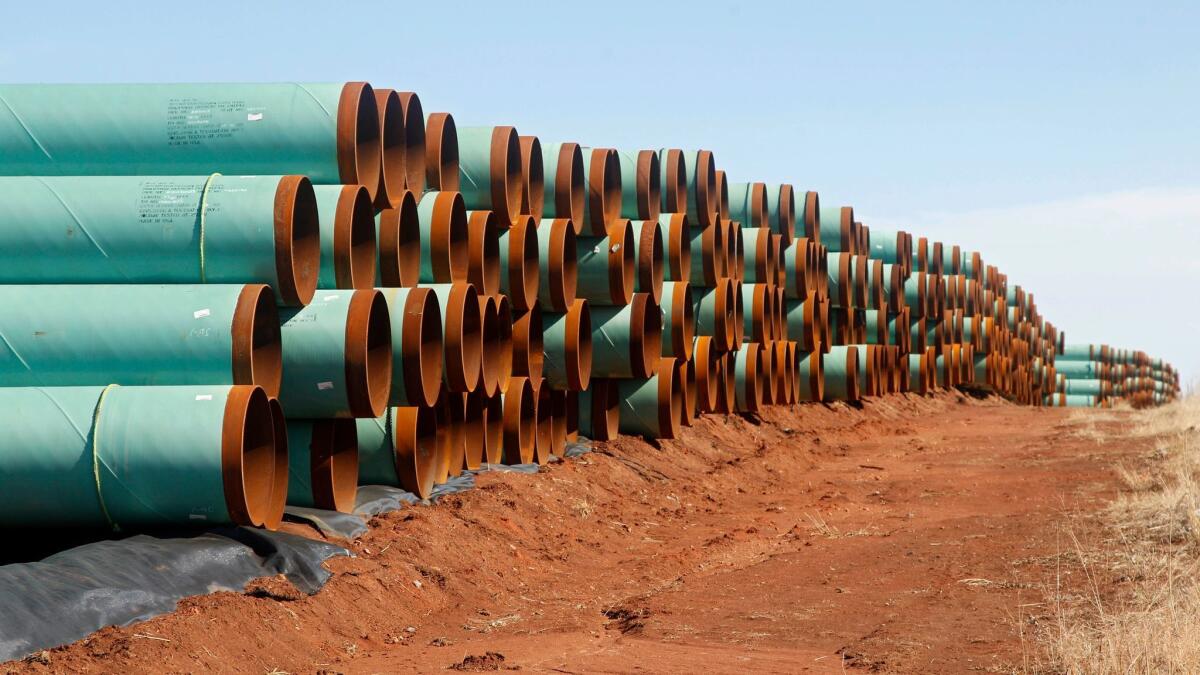Opinion: Keystone Pipeline and other Trump energy policies could help swamp Mar-a-Lago

President Trump’s State Department early Friday signed off on a permit to allow the Keystone XL Pipeline project to cross the border from Canada, a permit the Obama administration had rejected as contrary to the national interest. But Trump is less concerned with the nation’s best interests than he is in the interests of the oil industry, so he reversed the Obama administration’s decision.
Still, Keystone XL is not a done deal. The pipeline was conceived when oil prices were higher, and extracting oil from tar sands, which would be the source for the pipeline, is expensive, so the financials might not quite be right for TransCanada, the firm behind the pipeline, to proceed. And it still faces hurdles in acquiring rights and land along the route — and likely legal challenges — particularly in Nebraska.
Granted, Trump is doing just what he said he would do — hurtle the nation toward a warmer, less hospitable world climate. His approval of Keystone, and his resurrection of the Dakota Access Pipeline, are part of his desire to expand the nation’s reliance on fossil fuels for energy — a policy that seems crafted in the 1950s, not at a time when the world is already experiencing significant climate change from global warming propelled by burning the very fuels Trump has so hugely embraced.
The odd part is that Palm Beach, site of Trump’s prized Mar-a-Lago (he calls it the Winter White House; I see it more as the Winter Palace), has been actively seeking ways to protect itself from the seas encroaching on the Florida coast.
In fact, some climate models project that Mar-a-Lago could become Atlantis within 80 years. And though Trump once called climate change a hoax, he’s been trying to build a sea wall to protect one of his seaside golf courses in Ireland from the advancing ocean.
One Florida scientist believes seasonal high tides and rising seas will lead to such frequent flooding that barrier islands like Palm Beach will become uninhabitable by mid-century because of the damage to roads, water pipes and other key infrastructure. But hey, let’s build that pipeline and burn more fossil fuels.
Some climate models project that Mar-a-Lago could become Atlantis within 80 years.
Keystone was sold in part as a job creator. Yet, most of the jobs will be temporary construction work, which is fine, but the long-term costs and risks for such a short-term gain makes it a bad trade-off. Proponents argue that if the pipeline is halted the oil will get delivered anyway by truck or train, methods that are susceptible to more accidents.
While it’s true that such transportation could lead to more frequent accidents, the environmental damage from a single pipeline leak, with its constant flow of oil, far exceeds that of a truck tanker splitting open or an oil train derailing.
More importantly, the U.S. — and the world — need to shift from expanding an oil infrastructure to supporting renewable energy, and moving away from gasoline-fired engines to electric or other power sources with a much lighter carbon footprint. Trump’s approval of Keystone — and his looming plans to undo other crucial environmental regulations enacted by the Obama administration — will lead us to a more dangerous, unhealthy and unstable future.
There’s nothing great about that for America. Or the world.
Follow my posts and re-tweets at @smartelle on Twitter
More to Read
A cure for the common opinion
Get thought-provoking perspectives with our weekly newsletter.
You may occasionally receive promotional content from the Los Angeles Times.











